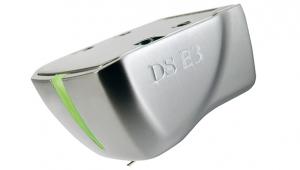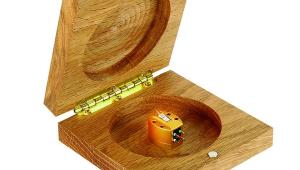B&O Beogram 4002 Turntable Page 2
In common with all the other big B&O designs, the Beogram 4002 has a sound of its own. Auditioning this deck made me realise that, very often, the cherished 'sound of vinyl' is as much a function of the the turntable as the medium itself...
![]() Tim Listens
Tim Listens
Enter the room when this turntable is playing and you might well find it difficult to determine whether the source you are hearing is vinyl or CD. To be more precise, the 4002 doesn't quite have the detached, ethereally poised sound of the later Beogram 8000, with its single crystal sapphire cantilevered MMC20CL cartridge. But this example, fitted with the correct MMC20EN, came pretty close. The most striking feature was the absence of surface noise, yet there was also no 'sting' or undue sparkle to the sound. Rather, the top end sounded smooth and ever so slightly clipped, just like an old Philips CD player.

It's worth noting B&O recommended a minimum operating temperature of 18oC for these cartridges – run them too cold and they sound dull. In the lower registers, the sound was warm and plump yet the bass showed tight control with no sign of bloom or other forms of unruliness during even the loudest of passages. The short and stiff arm coupled with the top-drawer subchassis isolation are probably what makes this possible. Compared with the Beogram 4000's AC drive the new Matsushita DC motor seems to give a brisker presentation – the change is a small one but I'd say that the improvement is certainly worthwhile.
The Beogram 4002 isn't perfect though. It could have been a tad brighter in the treble, for example. Yet the most obvious drawback is a swishing noise that can be heard during quiet passages if the record you are playing isn't completely flat.
Great Escape
This effect is a result of a warped disc not sitting uniformly on the hard black plastic ribs that form the turntable's 'mat'. The depth of the lid and design of the hub precludes the use of a clamp, so there's little that can be done should you encounter this issue, beyond a more obsessive approach to record care.
I couldn't resist playing Boney M's Nightflight To Venus [Hansa K 50498] while evaluating the 4002. It was like escaping the grinding drabness of 2023's winter and popping up in the hedonistic 1970s. The big mixes on this LP revealed the Beogram 4002's exceptional bass quality – it is just so well defined and taut without ever sounding bland and dry. A large, solid soundstage was also projected, one with strong vocal centre presence and an explicit sense of space around the performers and their instruments.

Fun though this all was, I did find myself feeling slightly guilty that I wasn't making the best use of this most refined of tools. Swapping the Boney M disc for a recording of Beethoven's Concerto For Piano And Orchestra No 1 Op. 15 [Deutsche Grammophon 2532 103] created one of those rare experiences where it is possible to completely divorce the enjoyment of the music from what is being used to play it. The delicate piano line in the Largo was just exquisite when rendered by the 4002 – a real 'close your eyes and be there' moment. It isn't easy to describe, but if you know what a real piano sounds like, be assured that the 4002 nails it.
Nobody's Fool
Whether you will enjoy the Beogram 4002 will depend largely on what you want a turntable for. If you enjoy the traditional sound of vinyl replay, with the deck itself contributing to the overall sound, or whether it's just for nostalgic reasons, this won't be the turntable for you. If, on the other hand, you want to extract as much detail from your legacy record library using a vintage player that works with foolproof machine intelligence, then this accurate and precise-sounding deck may be ideal. As B&O said at the time, the Beogram 4002 was for playing records, not for playing with them.
Buying Secondhand
The 4002 used to be considered the poor relation to the 4000, but this has changed in recent years, though condition remains a critical factor. B&O has not made cartridges for many years, meaning an original pick-up in good condition is a must. Note that B&O's top cartridges were always silver; a black one will be a replacement from a lesser model.

Internally, seizure of the cueing mechanism causes most of the problems. In early examples this can burn out the solenoid so it must be carefully checked before the turntable is returned to use. Some of the replacement belts currently on sale are slightly too small, pulling the platter towards the motor and reducing the effectiveness of the suspension. If you plan to play 7in singles it's essential to check that the record-size detector works – if it doesn't then the stylus can end up being cued into the rotating ribs of the platter, with disastrous results.
Hi-Fi News Verdict
The Beogram 4002 may not be the most coveted variant of B&O's big tangential tracking player but it's a marginally better performer than the original 4000 and sturdier and simpler than the later 8000 range. As such, it represents an ideal way to sample what these remarkable machines can do. B&O made thousands and many are still in circulation, so there is no need to settle for anything but the best examples.


















































